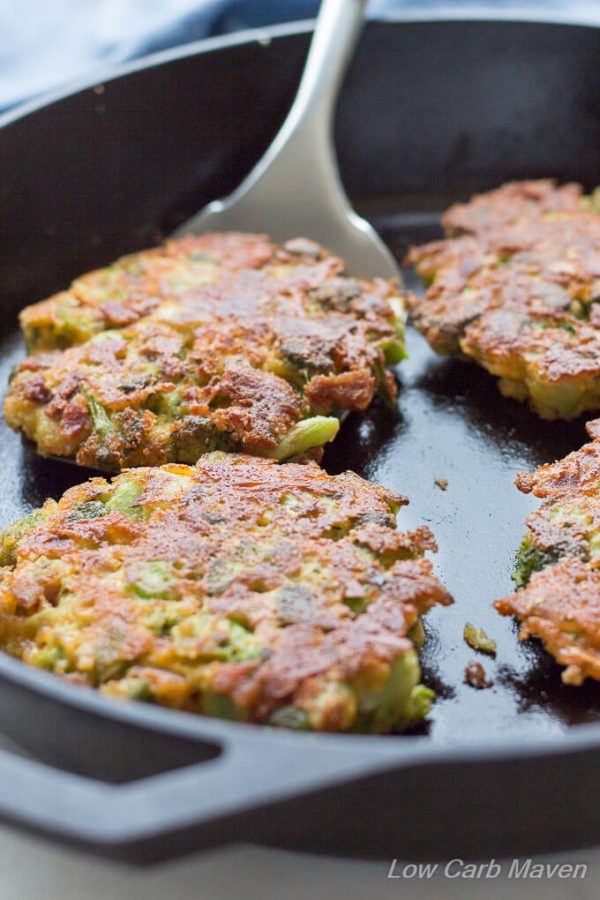These easy broccoli fritters are made with cheddar cheese and have a hearty toothsome bite! A minimum of ingredients keeps this recipe healthy and low carb too.
I recently visited my family in Texas and wowed my sister-in-law with broccoli fritters for breakfast. I simply used leftover broccoli from dinner the night before. But lets get real… No ones excited about eating leftover vegetables… BUT A FRITTER? That’s exciting!
Trying to get kids (and some adults) to eat vegetables sometimes calls for new or imaginative ways to present them. For the most part my family loves vegetables but we can become tired of eating our favorites, like broccoli, the same way every week. Enter the fritter!
Broccoli fritters are my new veggie obsession. I typically make zucchini fritters in the Summer to help use the bounty we receive from neighbors. And my husband swears that cauliflower fritters make the best low carb hash brown substitute around. But there’s something about the toothsome bite of these broccoli fritters that has me making them every week.
Trim the base with a peeler, finely chop the most fibrous ends, and slice the rest in half vertically from the floret down, so thinning the thick stem. And if you ever have any leftover cooked broccoli, cook it up a second time to make this savoury dip that also doubles as a pasta sauce.

Broccoli Fritters With Cheddar Cheese are 8 net carbs per large fritter.

How to Make Fritters
If youve never made vegetable fritters, you’ll love how easy they are to make. Typically, vegetable fritters are made with chopped, mashed, or grated vegetables mixed with a batter then fried in a pan.
They’re often formed into patties or pancakes, shaped into logs or croqeuttes, or rolled into balls and deep fried.
Common binding ingredients for fritters are flour, eggs, and cheese, but gluten-free flours like chickpea or almond flour are common replacements in gluten-free and low carb recipes.

Since this is a low carb recipe, youll see that I use an alternative flour as well as lightly steamed fresh cut broccoli, eggs, and cheddar cheese. If you are dont follow a low carb diet, feel free to use all purpose flour. The recipe is forgiving and using leftover broccoli from a previous meal works well, too.
As you can see from the photos, I like to keep my broccoli pieces a little bigger. It appeals to me visually and I enjoy the crunch of the bigger pieces. I steam mine after cutting. BUT, if you like your broccoli in smaller pieces, steam first and then chop. I prefer pre-grated cheese and the finer the grate the better, but freshly grated cheese works well, too (as seen in the photos).
How to cook broccoli without losing its anti-inflammatory and anti-cancer properties!
FAQ
How long will cooked broccoli last in the fridge?
Can I reheat cooked broccoli?
Can cooked broccoli be left out overnight?
What happens to overcooked broccoli?
Is reusing leftover Broccoli a good idea?
By repurposing leftover broccoli, you contribute to the reduction of food waste in landfills, subsequently lowering greenhouse gas emissions and other environmental harm. Financially, reusing leftover broccoli makes sense, too. Discarding food equates to throwing away the money used to purchase it.
How can one store broccoli and for how many days?
Broccoli can be stored in a cool, dry place for perhaps a week. Then it can be frozen. For this, it is recommended to keep it cooked, either boiled or sautéed.
Should Broccoli be refrigerated?
If your broccoli is damp from the store, or if you’ve rinsed it, ensure it’s completely dry before refrigeration. Then, place the clean, dry broccoli loosely in the plastic bag it came with—with or without paper towels to soak up excess moisture.
Can you put leftover Broccoli in the trash?
Don’t toss your leftover broccoli in the trash. Here are five delicious recipes that put it to good use, saving you money and reducing food waste. Ever considered the fact that nearly one-third of the food produced for human consumption worldwide goes to waste every year?
